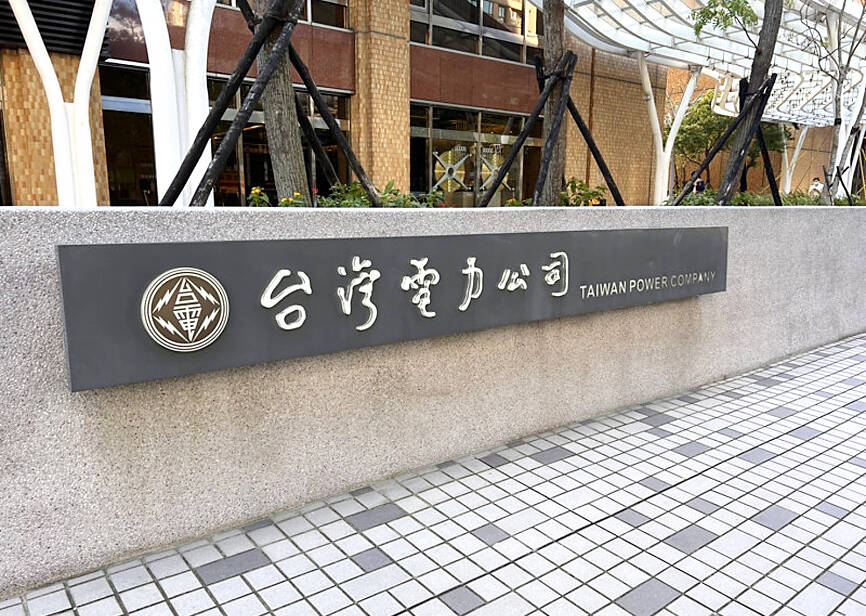Electricity rate hikes and cash injections would slow debt leverage at Taiwan Power Co (Taipower, 台電), but not fast enough to reverse the uptrend, Taiwan Ratings Corp (中華信評) said in a note yesterday.
High operating costs and capital spending needed to shift Taiwan’s power structure toward renewable sources accounted for the observation, the local arm of S&P Global said.
The government last week announced that it would increase electricity prices by 11 percent to NT$3.1154 per kilowatt-hour (kWh), effective next month, to keep Taipower afloat, but the adjustment is still lower than the company’s service costs, which stood at NT$4.4054 kWh in January, it said.

Photo: Lin Jing-hua, Taipei Times
The government earlier indicated it would give Taipower a NT$200 billion (US$6.54 billion) injection to help ease its losses.
However, the tariff hikes and fund injections are insufficient to finance Taipower’s operation and capital expenditure without aggravating its debt, Taiwan Ratings said.
Taipower incurred NT$32.1 billion in pretax losses in January and the figure is expected to spike to NT$200 billion in December after factoring in the tariff increase, it said, adding that it expects fuel prices to fall gradually for the rest of the year.
That means Taipower’s debt could widen to NT$1.4 trillion toward the end of this year from NT$1.2 trillion in June last year, it said.
“We do not expect Taipower to turn around its operations and improve its capital structure any time soon, as its servicing costs remain significantly higher than the average tariff,” Taiwan Ratings said in the note.
Furthermore, costs aimed at increasing the use of energy from renewable sources are much higher and would rise fast in the next two years, the ratings agency said.
Such capital spending could augment the company’s debt unless fuel costs drop significantly, it said.
Taiwan Ratings said it expects the government to provide additional cash injections and increase electricity rates further if it is necessary to support Taipower’s capital and viability, as well as help enhance the resilience and reliability of the utility’s power grids.
Taipower last year unveiled a NT$564.5 billion power grid enhancement plan for the next 10 years, aiming to prevent massive outages from affecting industrial production and people’s lives.
The utility is drafting a NT$33.4 billion distribution system upgrade plan over the next five years as it hopes to further limit the duration of power outages and decrease the number of blackouts, the Chinese-language Liberty Times (the Taipei Times’ sister publication) reported on its Web site yesterday.

The US dollar was trading at NT$29.7 at 10am today on the Taipei Foreign Exchange, as the New Taiwan dollar gained NT$1.364 from the previous close last week. The NT dollar continued to rise today, after surging 3.07 percent on Friday. After opening at NT$30.91, the NT dollar gained more than NT$1 in just 15 minutes, briefly passing the NT$30 mark. Before the US Department of the Treasury's semi-annual currency report came out, expectations that the NT dollar would keep rising were already building. The NT dollar on Friday closed at NT$31.064, up by NT$0.953 — a 3.07 percent single-day gain. Today,

‘SHORT TERM’: The local currency would likely remain strong in the near term, driven by anticipated US trade pressure, capital inflows and expectations of a US Fed rate cut The US dollar is expected to fall below NT$30 in the near term, as traders anticipate increased pressure from Washington for Taiwan to allow the New Taiwan dollar to appreciate, Cathay United Bank (國泰世華銀行) chief economist Lin Chi-chao (林啟超) said. Following a sharp drop in the greenback against the NT dollar on Friday, Lin told the Central News Agency that the local currency is likely to remain strong in the short term, driven in part by market psychology surrounding anticipated US policy pressure. On Friday, the US dollar fell NT$0.953, or 3.07 percent, closing at NT$31.064 — its lowest level since Jan.

The Financial Supervisory Commission (FSC) yesterday met with some of the nation’s largest insurance companies as a skyrocketing New Taiwan dollar piles pressure on their hundreds of billions of dollars in US bond investments. The commission has asked some life insurance firms, among the biggest Asian holders of US debt, to discuss how the rapidly strengthening NT dollar has impacted their operations, people familiar with the matter said. The meeting took place as the NT dollar jumped as much as 5 percent yesterday, its biggest intraday gain in more than three decades. The local currency surged as exporters rushed to

PRESSURE EXPECTED: The appreciation of the NT dollar reflected expectations that Washington would press Taiwan to boost its currency against the US dollar, dealers said Taiwan’s export-oriented semiconductor and auto part manufacturers are expecting their margins to be affected by large foreign exchange losses as the New Taiwan dollar continued to appreciate sharply against the US dollar yesterday. Among major semiconductor manufacturers, ASE Technology Holding Co (日月光), the world’s largest integrated circuit (IC) packaging and testing services provider, said that whenever the NT dollar rises NT$1 against the greenback, its gross margin is cut by about 1.5 percent. The NT dollar traded as strong as NT$29.59 per US dollar before trimming gains to close NT$0.919, or 2.96 percent, higher at NT$30.145 yesterday in Taipei trading